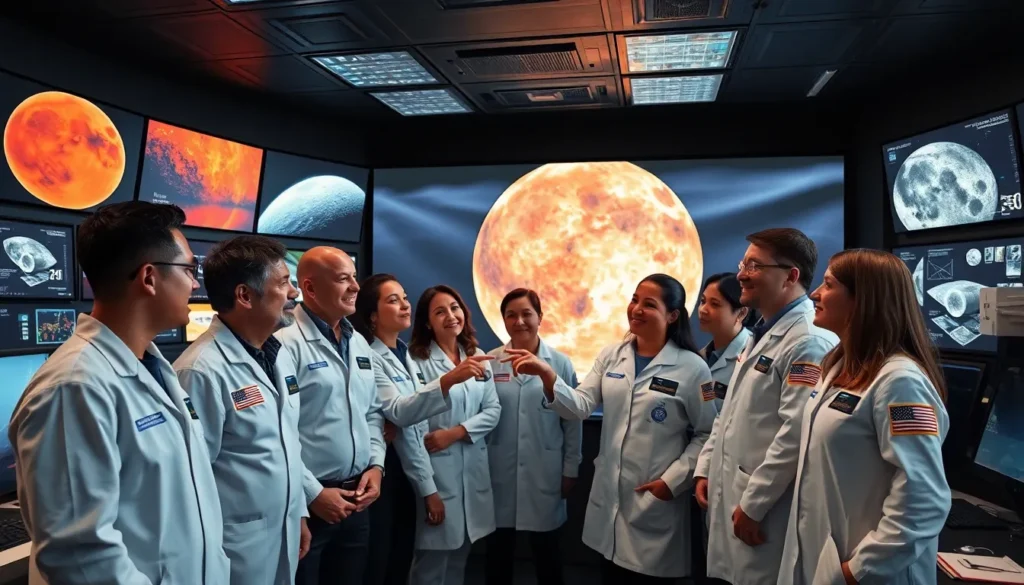In an age where the mysteries of the universe captivate the imagination, cosmic exploration initiatives are pushing the boundaries of human knowledge. From ambitious missions to Mars to the study of distant exoplanets, these initiatives reveal the potential for groundbreaking discoveries that could reshape our understanding of life beyond Earth.
Governments and private organizations alike are investing heavily in space technology and research, igniting a new era of exploration. As they strive to unlock the secrets of the cosmos, they not only seek to answer age-old questions but also inspire future generations to look to the stars. The journey into the unknown promises not just scientific advancements but also a deeper connection to the universe we inhabit.
Table of Contents
ToggleOverview of Cosmic Exploration Initiatives
Cosmic exploration initiatives encompass a diverse range of programs and missions designed to investigate the universe, enhance scientific knowledge, and push the boundaries of human space endeavors. Governments and private entities actively participate in these initiatives, focusing on both manned and unmanned missions.
Key Government Initiatives
- NASA’s Artemis Program: Aims to return astronauts to the lunar surface by 2024, establishing a sustainable human presence on the Moon.
- European Space Agency (ESA): Conducts missions like the Mars Express and the ExoMars rover, seeking evidence of past life on Mars.
- Indian Space Research Organisation (ISRO): Initiatives like the Chandrayaan and Mangalyaan programs explore the Moon and Mars, respectively, showcasing affordable space exploration.
Prominent Private Sector Efforts
- SpaceX: Develops the Starship spacecraft for missions to Mars, focusing on reusable technology to lower mission costs.
- Blue Origin: Aims to establish space tourism and expand human presence in low Earth orbit with its New Shepard and New Glenn rockets.
- Virgin Galactic: Offers suborbital spaceflights, promoting commercial space travel for civilians.
International Collaboration
- International Space Station (ISS): A collaborative project involving NASA, ESA, Roscosmos, JAXA, and CSA, which facilitates scientific research in space since 2000.
- Lunar Gateway: Planned as a multinational outpost orbiting the Moon, enabling deeper exploration of lunar and potentially Martian environments.
Scientific Missions and Discoveries
- James Webb Space Telescope: Launched to study the universe’s earliest galaxies, the telescope provides unprecedented insights into stellar and planetary formation.
- Parker Solar Probe: Currently studying the Sun’s outer atmosphere, the probe aids in understanding solar activity and its effects on space weather.
Educational and Outreach Programs
- STEM Engagement: Many initiatives incorporate educational outreach, promoting science and engineering careers by engaging students and communities in space research.
- Citizen Science Projects: Programs such as Galaxy Zoo invite public participation in classifying galaxies and observing phenomena, fostering wider community involvement in cosmic exploration.
These initiatives exemplify the collaborative and innovative spirit driving humanity’s quest to explore and understand the cosmos. Such efforts not only advance scientific knowledge but also inspire curiosity about the universe.
Recent Breakthroughs in Cosmic Exploration
Recent advancements in cosmic exploration showcase initiatives that push the boundaries of human knowledge and technology. These breakthroughs primarily focus on Mars missions and lunar exploration.
Mars Missions
NASA’s Perseverance rover, launched in February 2021, conducts astrobiological research on Mars. It analyzes rock and soil samples for signs of ancient microbial life. The rover also tests technology for future human exploration, including producing oxygen from the Martian atmosphere.
The European Space Agency’s ExoMars program aims to launch the Rosalind Franklin rover in 2024. This mission will investigate the composition of Martian soil and sub-surface materials. Furthermore, China’s Tianwen-1 mission has successfully orbited Mars, mapping regions and sending a rover that captures detailed images and atmospheric data.
Lunar Exploration
NASA’s Artemis Program aims to return humans to the Moon by 2024. Artemis I, an uncrewed test flight, successfully completed its mission in late 2021, paving the way for Artemis II, which will involve a crewed flyby of the Moon. This initiative supports long-term lunar habitation plans, including the Lunar Gateway, a space station in orbit around the Moon designed for future missions to Mars.
India’s Chandrayaan-3 mission continues to gather critical lunar data, focusing on the Moon’s surface and mineral compositions. Moreover, increasing private investments from companies such as SpaceX, which launched the Crew Dragon to the International Space Station, indicate a growing interest in lunar exploration. These efforts represent a collaborative approach towards sustainable human presence on the Moon and beyond.
Notable Organizations Involved
Numerous organizations are pivotal in cosmic exploration initiatives, driving technological advancements and expanding our knowledge of the universe. Notable contributions come from both government agencies and private companies pursuing ambitious space goals.
NASA’s Role
NASA plays a central role in cosmic exploration efforts through its extensive programs and missions. The Artemis Program aims for a sustainable lunar presence, with plans to send astronauts back to the Moon by 2024. NASA’s Perseverance rover conducts in-depth astrobiological studies on Mars, exploring the planet’s geology and climate to search for signs of past life. Furthermore, the agency’s involvement in the James Webb Space Telescope enhances its ability to observe distant galaxies and exoplanets, pushing the frontiers of astrophysics.
Private Sector Contributions
Private organizations significantly contribute to cosmic exploration. SpaceX leads the way with its reusable Falcon rockets, drastically reducing the cost of space travel. Blue Origin focuses on suborbital tourism and lunar landers, promoting public interest in space. Virgin Galactic provides commercial spaceflight experiences, making space more accessible to individuals. These companies collaborate with governmental agencies, enhancing capabilities and driving innovation in spacecraft design and technology.
Challenges Facing Cosmic Exploration Initiatives
Cosmic exploration faces numerous challenges that hinder progress and achieve ambitious goals. These challenges include:
- Financial Constraints
Funding for cosmic initiatives relies on governmental budgets and private investments. Limited resources may restrict mission scope or delay projects. Costs often exceed initial estimates, impacting long-term strategies.
- Technological Limitations
Developing reliable technology for deep space exploration presents complex engineering challenges. Systems must endure extreme conditions, such as radiation and temperature fluctuations. Innovations in propulsion, communication, and life support remain critical for crewed missions.
- Safety Concerns
Human safety is a priority during space missions. Risks include exposure to cosmic radiation, equipment malfunctions, and psychological stress. Ensuring astronaut wellbeing requires robust training and contingency plans.
- International Cooperation
Successful cosmic exploration often requires collaboration among nations. Geopolitical tensions can hinder partnerships, impacting joint missions. Diverse regulatory frameworks complicate cooperation and information sharing.
- Environmental Considerations
Space missions incur environmental responsibilities. Launches produce greenhouse gases and debris that pollute Earth’s atmosphere and orbit. Sustainable practices must be prioritized to minimize ecological impacts.
- Public Engagement
Maintaining public interest and support is vital for funding and participation. Challenges include competing priorities and short attention spans. Effective communication of scientific achievements helps sustain enthusiasm.
- Regulatory Hurdles
Space activities face numerous regulations governing operations. Compliance with national and international laws can delay approvals and limit operations. Streamlining regulations may enhance exploratory capabilities.
- Uncertainty of Discovery
Cosmic exploration involves inherent unpredictability. Missions may yield data that challenges existing theories or leads to unforeseen obstacles. Adapting to new findings requires flexibility and resilience within teams.
Addressing these challenges is crucial for advancing cosmic exploration initiatives. By overcoming barriers, humanity can deepen its understanding of the universe and make progress toward future discoveries.
Future Prospects and Goals
Cosmic exploration initiatives aim to expand human knowledge and capabilities in space. These efforts focus on key goals that guide ongoing missions and future projects.
- Lunar Exploration: NASA’s Artemis Program targets sustainable human presence on the Moon by 2024. This initiative creates a foundation for future Mars missions and establishes long-term scientific research on lunar geology and resources.
- Mars Missions: Perseverance rover actively conducts astrobiological research on Mars, while the upcoming ExoMars mission plans to launch the Rosalind Franklin rover in 2024. These missions aim to uncover signs of past life and assess the planet’s habitability.
- Deep Space Exploration: The James Webb Space Telescope seeks to provide insights into the early universe and the formation of celestial bodies. Upcoming missions, such as the Lunar Gateway, enhance collaboration between international space agencies in deep-space exploration.
- Public Engagement: Educational outreach programs connect with future generations, fostering a passion for space science. Initiatives targeting schools and public forums encourage broader participation in cosmic research and discussions.
- Technological Advances: The use of reusable launch systems, as demonstrated by SpaceX, reduces travel costs while making space access more efficient. Continued innovation remains critical for addressing complex challenges in deep space travel.
- Environmental Considerations: Space missions prioritize minimizing environmental impacts both on Earth and in space. Strategies include responsible waste management and sustainable resource utilization during exploration activities.
- International Collaboration: Strengthened partnerships among countries drive joint projects, sharing knowledge and resources. Collaboration through platforms like the International Space Station fosters innovation and problem-solving.
- Resilience to Challenges: Flexibility in mission planning accommodates new discoveries and unforeseen challenges. Developing adaptive systems remains vital for ensuring ongoing success in cosmic exploration.
Cosmic exploration initiatives emphasize ambitious goals, fueled by international cooperation and technological advancements. These objectives align with humanity’s quest for knowledge and deeper connections to the universe.
The future of cosmic exploration is bright and filled with potential. As initiatives continue to evolve and expand, the quest for knowledge about the universe will inspire innovation and collaboration. The combined efforts of government agencies and private organizations are reshaping our understanding of space and our place within it.
With ambitious missions to the Moon and Mars on the horizon, humanity stands on the brink of new discoveries. Engaging the public and fostering interest in space research will be vital for sustaining momentum. As challenges arise, adaptability and cooperation will play key roles in overcoming obstacles. The journey into the cosmos promises not only scientific advancements but also a deeper connection to the mysteries that lie beyond our planet.








